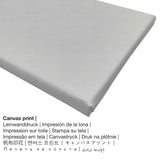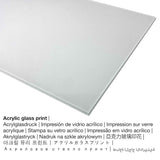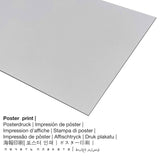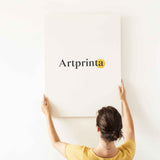Paul Cézanne - The Large Bathers (Les Grandes bathers) - bản in mỹ thuật
Đã bao gồm thuế. Vận chuyển được tính lúc thanh toán.
Thông số kỹ thuật của sản phẩm nghệ thuật
Kiệt tác này được tạo ra bởi Nam giới họa sĩ Paul Cézanne. Bản gốc đo kích thước - Tổng thể: 52 1/8 x 86 1/4 inch (132,4 x 219,1 cm). Oil on canvas was used by the painter as the technique for the work of art. Today, this artpiece is included in the Quỹ Barnes bộ sưu tập nghệ thuật. Với sự lịch sự của: Phép lịch sự của Quỹ Barnes, Merion và Philadelphia, Pennsylvania (phạm vi công cộng).Besides, the work of art has the creditline: . Moreover, alignment is cảnh quan và có tỉ lệ 16: 9, ngụ ý rằng chiều dài hơn chiều rộng 78%. Paul Cézanne was a painter of French nationality, whose style can mainly be classified as Impressionism. The French artist lived for a total of 67 năm, sinh năm 1839 và viên tịch năm 1906 tại Aix-en-Provence.
Nhận chất liệu sản phẩm mong muốn của bạn
Chúng tôi cung cấp nhiều loại vật liệu và kích cỡ khác nhau cho mọi sản phẩm. Các kích thước và vật liệu sau đây là các tùy chọn chúng tôi cung cấp cho bạn để cá nhân hóa:
- In kính acrylic (với lớp phủ kính thật): The print on acrylic glass, which is sometimes referred to as a UV print on plexiglass, makes the original work of art into marvellous décor. Your favorite artwork is being printed with the help of modern UV direct printing machines. The result of this are impressive, vivid colors. The major benefit of a plexiglass fine art print is that contrasts and image details become more exposed due to the granular tonal gradation.
- In vải: The printed canvas, not to be confused with an artwork painted on a canvas, is an image printed from an industrial printing machine. Canvas prints are relatively low in weight, meaning that it is quite simple to hang up the Canvas print without extra wall-mounts. Therefore, canvas prints are suitable for any type of wall.
- In poster trên chất liệu canvas: Sản phẩm Artprinta poster print is a printed sheet of canvas with a slight structure on the surface. Please note, that depending on the size of the poster we add a white margin of approximately 2-6cm around the print motif to facilitate the framing.
- Nhôm dibond (bản in kim loại): An Aluminium Dibond print is a material with an impressive depth, creating a contemporary look throuch a surface , which is not reflective. A direct Direct Print on Aluminum Dibond is the perfect start to art replicas produced on aluminum. For the Direct Aluminium Dibond option, we print the artwork right on the aluminium white-primed surface. The colors of the print are luminous, fine details of the print appear clear and crisp. The direct print on aluminium is the most popular entry-level product and is a sophisticated way to display fine art reproductions, because it puts the viewer’s attention on the image.
Important note: We try everythig possible to describe our art products with as many details as possible and to showcase them visually in our shop. At the same time, some pigments of the print products and the print result can differ slightly from the image on the device's monitor. Depending on your screen settings and the condition of the surface, not all colors can be printed as exactly as the digital version on this website. Given that our art reproductions are processed and printed manually, there might as well be slight discrepancies in the motif's exact position and the size.
Chi tiết mặt hàng có cấu trúc
| Phân loại bài viết: | sao chép nghệ thuật |
| Sinh sản: | sao chép ở định dạng kỹ thuật số |
| Quy trình sản xuất: | In trực tiếp UV (in kỹ thuật số) |
| Xuất xứ sản phẩm: | sản xuất tại Đức |
| Loại chứng khoán: | theo yêu cầu |
| Mục đích sử dụng sản phẩm: | thư viện in nghệ thuật, thiết kế nhà |
| Căn chỉnh hình ảnh: | căn chỉnh cảnh quan |
| Tỷ lệ hình ảnh: | chiều dài đến chiều rộng 16: 9 |
| Diễn dịch: | chiều dài hơn chiều rộng 78% |
| Các loại vải sinh sản có sẵn: | in thủy tinh acrylic (với lớp phủ thủy tinh thật), in canvas, in áp phích (giấy canvas), in kim loại (nhôm dibond) |
| Các biến thể kích thước in canvas (vải trên khung cáng): | 90x50cm - 35x20", 180x100cm - 71x39" |
| Các biến thể kích thước in trên kính acrylic (với lớp phủ kính thật): | 90x50cm - 35x20", 180x100cm - 71x39" |
| Tùy chọn in áp phích (giấy canvas): | 90x50cm - 35x20" |
| Tùy chọn kích thước in nhôm: | 90x50cm - 35x20" |
| Frame: | không bao gồm |
Thông tin cơ bản về tác phẩm nghệ thuật độc đáo
| Tên bức tranh: | "The Large Bathers (Les Grandes bathers)" |
| Phân loại tác phẩm nghệ thuật: | bức tranh |
| Phương tiện ban đầu: | dầu trên vải |
| Kích thước ban đầu của tác phẩm nghệ thuật: | Tổng thể: 52 1/8 x 86 1/4 inch (132,4 x 219,1 cm) |
| Bảo tàng/bộ sưu tập: | Quỹ Barnes |
| Nơi bảo tàng: | Philadelphia, Pennsylvania, Hợp chủng quốc Hoa Kỳ |
| Trang web của bảo tàng: | Quỹ Barnes |
| Loại giấy phép của tác phẩm nghệ thuật: | phạm vi công cộng |
| Được phép của: | Phép lịch sự của Quỹ Barnes, Merion và Philadelphia, Pennsylvania |
Về nghệ sĩ
| Artist: | Paul Cézanne |
| Giới tính của nghệ sĩ: | Nam giới |
| Quốc tịch của nghệ sĩ: | Tiếng Pháp |
| Nghề nghiệp: | họa sĩ |
| Quốc gia: | Nước pháp |
| Styles: | Ấn tượng |
| Tuổi thọ: | 67 năm |
| Năm sinh: | 1839 |
| Chết vào năm: | 1906 |
| Nơi chết: | Aix-en-Provence |
Văn bản này có bản quyền © | www.artprinta.com (Artprinta)
Mô tả chung từ bảo tàng (© Bản quyền - Tổ chức Barnes - www.barnesfoundation.org)
In the last decade of his life, Paul Cézanne produced three enormous multi-figure bathing scenes that are often regarded as the culminating works of his career. Of these, the largest and most resolved is at the Philadelphia Museum of Art; another is at the National Gallery, London. The present canvas, which Albert Barnes acquired in 1933, is in many ways the most ambitious of the trio. Probably begun around 1895, The Large Bathers is an intensely physical painting that seems to have consumed Cézanne for roughly ten years; a photograph taken in 1904 shows the picture in a still-unfinished state. But even without this documentary evidence, the canvas bears the marks of a long, labored working process, with a surface so impossibly thick with paint that it rises up in clumps in some areas and forms sculptural ridges in others.The subject is perfectly conventional: a group of nudes relaxes in a landscape, with trees arching overhead and still-life elements in the foreground, tropes borrowed from a long tradition of pastoral imagery. There is nothing conventional, however, about the way this scene is painted. While Cézanne's contemporaries often presented bathers in harmony with the landscape, here nature seems menacing, and the landscape's relationship to its human inhabitants is difficult to understand. Clouds are heavy, with an almost oppressive weight, and the blue sky peeking through them is rendered with paint so thick that it literally projects. One tree leans into the center, its sharp branches cutting aggressively across the sky in three parallel spokes. One wonders why, in this scene that presumably takes place in summer, these branches are bare; patches of green in the background suggest foliage, but the foreground trees around which the bathers gather are emphatically, eerily, dead.The figures themselves are at once beautiful and unsightly. They are elegantly arranged, in postures borrowed from classical sculpture and baroque painting. An unusual ridge of thick blue paint surrounding each of the figures lends the group an air of slowness, or serenity, even as it suggests artistic struggle. Colors are often breathtaking, as in the reds that spread across cheeks and hair, and in the pale blues and lavenders that suggest shadows. At the same time, Cézanne undermines 19th-century standards of beauty: skin is composed of patches that shift suddenly from one color to the next, and gender is difficult to read. Is the bather leaning against the tree a man or a woman? Paint pulled down between that figure's legs seems to want to obliterate sex. Anatomies are distorted, sometimes to disturbing effect—feet, hands, and fingertips often do not exist. The face of the figure leaning against the tree registers as a blank, with features buried beneath a blanket of brushstrokes. Even more jarring is the walking figure at left, whose towel cascades theatrically into the foreground but whose head is a mere knob of flesh.














